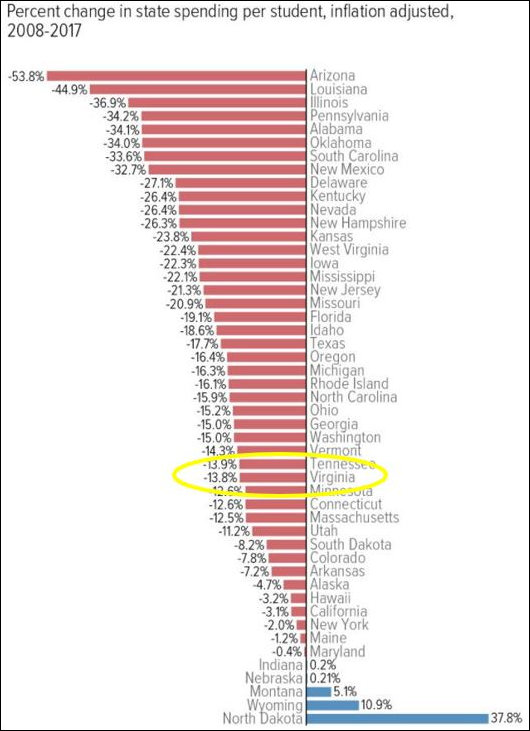
Image credit: Center for Budget and Policy Priorities
So, I was reading this op-ed piece in Inside NoVa by David S. Kerr, an instructor at Virginia Commonwealth University, in which he took the Republican supermajority in the General Assembly to task for slashing state support for higher education, increasing tuition levels, and rising student indebtedness. Then I got to the following paragraph:
States from New York to Nebraska have increased direct support to their university systems. State universities are a point of pride, particularly so out west, and states believe in supporting them–even in some of the reddest of red states. Virginia, however, as measured on a per student basis, has progressively cut state support for universities.
I wondered if that was an accurate portrayal. After Googling around, I found a recent report by the left-of-center Center on Budget and Policy Priorities, which published the chart above. As it turns out, New York cut higher-ed spending per student between 2008 and 2017 only 2.0%, and Nebraska increased spending by 0.2%. But thirty other states have cut higher-ed spending more than Virginia. Kerr isn’t telling the whole story.
Then he goes on:
Also, costs have gone up. They have to. Buildings wear out and technology needs to be updated. All sorts of scientifically based curricula require new, expensive equipment. There are also various administrative requirements, mandated by the state and the federal government, that the schools have to pay for. At the same time, faculty and non-faculty employees need to be competitively paid.
Oh, gee, costs have gone up. What that settles it. Just throw up your arms because there’s nothing else you can do. But someone forgot to tell Mitch Daniels. The former Indiana Governor took the helm at Purdue University in January 2013 vowing to make the public university more affordable.
After a 36-year string of increases, Purdue commenced a series of tuition freezes in 2013 that will last through the 2018-19 academic year. Daniels streamlined purchasing. He sold redundant property, reduced the cost of rental storage by half, and mended used office furniture. The university cut room and board costs by 5%. A partnership with Amazon.com slashed the cost of textbooks 31% on average. Thanks to these and other initiatives, Purdue student borrowing has dropped 37%.
As for those employees who “need to be competitively paid,” let me tell you how that works. Virginia colleges benchmark their faculty pay against that of institutions in other states and say, “We’ve got to raise pay to stay competitive.” This year the State Council of Higher Education for Virginia is recommending $84.3 million in extra state support (no guarantee it will get it) to keep faculty salaries competitive. Of course, higher-ed systems in other states are benchmarking as well, and they’re pushing for the same salary increases. And so the merry-go-round spins and spins.
Here in the Old Dominion, there’s still plenty of slack in the system. Universities can squeeze business process costs. They can cut administrative staff. They can curtail costly athletic programs. They can demand that faculty members teach more and publish less. They can harness online learning to provide classes at other institutions. They can utilize data analytics to spot struggling students and provide them the tutoring and mentoring they need to graduate on time.
Admittedly, cuts to state support in higher ed hasn’t made the job of Virginia colleges and universities any easier but the industry is rife with opportunity for cost cutting. The General Assembly bears a share of the blame for the higher-ed affordability crisis, but to pretend the problem starts and ends there is intellectually dishonest.


